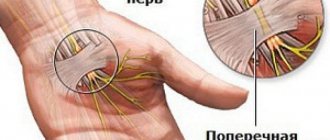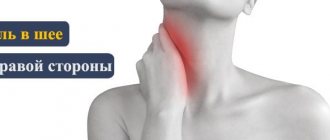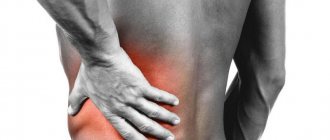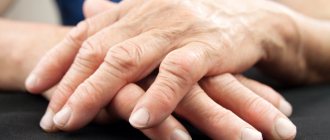Pain under the shoulder blade from the back is the body’s response to an external influence and the damage it causes, or to a serious illness. Syndrome on the right side of the back often manifests itself as a result of diseases of organs that seem completely unrelated to this part of the body. When the syndrome is temporary, stops quickly and does not appear later, there is nothing to worry about. If it is observed for a long time, causes real discomfort, intensifies, and becomes regular, then there is a need to urgently conduct an examination in a medical institution, since the consequences of such phenomena often become dire.
The main causes of pain under the right shoulder blade
Let's look at the main causes of back pain in the area of the right shoulder blade. Do not forget, the presence of this symptom may indicate a serious surgical disease that requires emergency medical attention.
Gallbladder diseases
Back pain in the area of the right shoulder blade is a common symptom in acute or chronic cholecystitis (inflammation of the gallbladder). Thus, local pain in the area of the inner corner of the right scapula, which increases with pressure, is called Kharitonov’s symptom - this is one of the specific signs of acute inflammation of the gallbladder. Similar points are present on the inside of the scapula in its lower part, and in the area of the transition of the scapula to the collarbone, on the right.
If there are stones in the gall bladder, which interfere with the flow of bile, intense abdominal pain occurs, radiating to the right shoulder blade, right shoulder, and interscapular space. The nature of the pain in the back is aching, pulling, while the pain in the abdomen is sharp, cutting, paroxysmal. If you have such symptoms, you should immediately consult a doctor for examination and to exclude acute surgical pathology.
Subphrenic abscess
Subphrenic abscess is an acute surgical disease, a complication of acute cholecystitis, appendicitis, and other surgical pathologies of the abdominal organs, in which pus accumulates. Most often, an abscess forms on the right, above the liver, and is accompanied by pain in the abdomen, lower back, and the right side of the back under the shoulder blade. Subphrenic abscess can also occur after surgery on the abdominal organs as a complication.
Bronchopulmonary diseases
Diseases of the bronchi and lungs, such as pleurisy, pneumonia, bronchopulmonary cancer, are almost always accompanied by pain in the chest and back. Due to the large number of pain receptors in the pleural cavity, pain can be sharp, acute, and intensify with breathing, coughing, and sneezing. The localization of pain is different and depends on the location of the focus in the lungs or pleural cavity.
Shpidonov Gennady Stanislavovich
Neurologist
Rostov State Medical University (neurology)
10 years of experience
Kidney diseases
Kidney diseases such as acute pyelonephritis, renal colic, kidney stones, abscess, cancer may be accompanied by pain in the shoulder blades. If the right kidney is affected, the patient will experience back pain under the right shoulder blade. If left, then left. The nature of the pain is sharp, pulling, cutting, paroxysmal, pain occurs simultaneously with pain in the lower back and hypochondrial areas in front. Fever, pain when urinating, nausea and vomiting are possible.
Diseases of the musculoskeletal system
Diseases of the musculoskeletal system are the main cause of pain in the shoulder blades. Among them are diseases such as spinal osteochondrosis, intervertebral disc herniation, scoliosis, spondyloarthritis and spondyloarthrosis. The source of pain can be a pathological muscle spasm that occurs due to instability of the spinal column, overstrain of the back muscles trying to compensate for the load on the sore back. It is characterized by constant aching pain that subsides with rest. With hernias and protrusions, pain can be caused by pinching of the spinal cord roots. The pain is sharp, acute, radiating to the shoulder blades, upper limbs, chest, and intensifies with physical activity and heavy lifting.
The immediate cause of pain behind the right or left shoulder blade from behind from the back may be associated with the shoulder blade itself, as happens with glenohumeral periarthritis. The disease occurs with degenerative-dystrophic damage to the shoulder joint, and is accompanied by inflammation of nearby soft tissues - muscles, ligaments and tendons. At the beginning of the disease, the pain is episodic in nature and occurs during physical activity, maximum elevation or abduction of the arm, and when throwing with the arm. Then they take on the character of constant pain, and bother you even at rest, sharply intensifying when you move your hand.
Muscle strain and inflammation
Muscle strain and inflammation (myositis) are common causes of pain in the shoulder blade, right or left. Pain occurs as a result of excessive physical activity, when playing sports, or lifting weights. As a result, microscopic ruptures of muscle fibers occur in the affected muscles, and minor hemorrhages are possible. Swelling and inflammation occurs at the site of injury. The pain is sharp and intensifies with movement and physical activity.
Myositis or muscle inflammation can be an independent disease that occurs due to hypothermia, draft, or intoxication due to acute respiratory viral infections. Less commonly, the disease is a consequence of autoimmune or rheumatic diseases. The pain is aching, prolonged, and intensifies with movement. The scapula area is affected quite often due to the presence of developed muscles.
Shpidonov Gennady Stanislavovich
Neurologist
Rostov State Medical University (neurology)
10 years of experience
Intercostal neuralgia
Neuralgia is attacks of sharp acute pain along the nerves, arising due to hypothermia, inflammation or irritation of the spinal cord roots in diseases of the spine. With intercostal neuralgia, pain spreads along the intercostal spaces and can be localized both under the right and left shoulder blades, behind the back, or on the sides and front of the chest. The pain is sharp, sharp, and worsens with breathing, movement, coughing or sneezing. The patient has to spare himself in attempts to relieve the pain, limiting the depth of breathing, trying not to cough or sneeze. In some cases, the pain can be so severe that it is necessary to resort to novocaine blockade of the intercostal nerves.
Diseases or injuries of the scapula
Diseases of the scapula that lead to pain include bruises, fractures and cracks of the scapula, benign and malignant tumors (sarcomas, osteochondromas, osteomas, etc.). Injuries occur due to direct physical impact (impact, falling on your back, traffic accident). A characteristic sign is pronounced swelling of the soft tissues in the area of the scapula, sharp acute pain, intensifying when moving the hand, crunching (in case of fractures, occurs due to friction of moving bone fragments).
With tumors, pain can be of a different nature, from aching, arching pain to severe pain. The pain is constant and not relieved by rest. Visually or by touch, a foreign dense and immovable formation in the area of the scapula associated with it can be determined.
Exercise therapy and massage
Massage and exercise therapy are quite effective in eliminating back pain. If the doctor allows it, then well-chosen exercises for right back pain can be quite effective . Exercise therapy does not take much time and some movements can be performed at the workplace.
Exercise for any pain is an excellent way to relieve discomfort. Therapeutic exercise always significantly improves well-being and is considered an essential element in the treatment of pain of various types.
For pain in the back, a very popular procedure is massage . It helps to cope with various diseases, as well as just relax. In case of intense pain in the right back area, therapeutic massage is mandatory.
It should be warned that exercise therapy and massage can be used only after identifying the cause of back pain on the right . Perhaps the cause is a serious illness and these treatment methods are contraindicated.
Types of pain under the shoulder blade on the right
Pain varies in severity and nature. Depending on the characteristics of the pain syndrome, it can be assumed what the underlying cause is. Thus, with intercostal neuralgia, the pain is almost always acute, intensifies with movement and coughing, turning into sharp shooting pains. Myositis is characterized by aching pain that can intensify with movement. Knowledge of the characteristics of pain syndrome in a particular pathology simplifies diagnosis.
Shpidonov Gennady Stanislavovich
Neurologist
Rostov State Medical University (neurology)
10 years of experience
Aching pain in the right shoulder blade
Aching pain in the area of the shoulder blades is characteristic of diseases of the musculoskeletal system, osteochondrosis, hernias and protrusions of intervertebral discs, myositis, and glenohumeral periarthritis in the initial stage. Similar pain can occur with diseases of the abdominal and thoracic organs, with neurological pathologies and pathologies of the spinal cord.
Acute pain under the shoulder blade on the right
Acute pain under the scapula on the right or left is a symptom characteristic of injuries, fractures, muscle strains, and tumors of the scapula. The cause of acute pain may be a hernia or protrusion of the intervertebral disc with radicular syndrome.
Sharp pain in the area of the right shoulder blade
Sharp pain in the area of the right shoulder blade is possible with intercostal neuralgia, diseases of the lungs, bronchi and pleura. Similar symptoms are observed with advanced glenohumeral periarthritis, severe myositis, and injuries.
Stitching pain behind the right shoulder blade
Stitching pain behind the right or left shoulder blade can be a symptom of diseases of the lungs and pleura (with pleurisy), myositis. Volatile stabbing pains are characteristic of radicular syndrome, when pain occurs due to pinching of the spinal cord roots, intercostal neuralgia.
Nagging pain in the right side of the back under the shoulder blade
A nagging pain in the right side of the back under the scapula is a symptom characteristic of acute or chronic cholecystitis, pancreatitis, and cholelithiasis. Similar symptoms can occur with kidney pathologies. Nagging pain in the right shoulder blade with a feeling of heaviness in the right hypochondrium may be a sign of subdiaphragmatic abscess, cirrhosis of the liver, or urolithiasis
Shpidonov Gennady Stanislavovich
Neurologist
Rostov State Medical University (neurology)
10 years of experience
Constant pain on the right side under the shoulder blade
Constant pain on the right or left under the scapula is a possible sign of a benign or malignant tumor of the scapula. Constant pain can also occur with chronic diseases of the spine, such as spondyloarthritis, spondyloarthrosis, osteochondrosis or intervertebral disc herniation.
Burning pain on the right side of the shoulder blade
Burning pain in the scapula area is a characteristic sign of herpes zoster before the appearance of rashes, intercostal neuralgia, and neuritis of the intercostal nerves. This symptom can occur with diseases of the spinal cord, such as multiple sclerosis, spinal cord tumors. Infringement of the spinal cord roots by a hernia in the thoracic spine can also lead to burning pain in the scapula area.
What to do if your back hurts in the shoulder blade area
Treatment of an emerging symptom without the necessary diagnosis and examination by a doctor is impossible. Only after determining the cause of the pathology can we proceed to its treatment. Since the pain that occurs is of a reflected nature, the focus of the disease is located at a distance from the shoulder blades. To identify and eliminate painful sensations, it is advisable to contact the following specialists:
- neurologist;
- traumatologist;
- cardiologist;
- gastroenterologist
First, the patient must visit a local doctor. He will perform an examination and refer you to the necessary specialist. Diagnosis will include a urine test and x-ray. The doctor may prescribe painkillers. If the pain is acute and is accompanied by a rise in temperature and vomiting, then you should definitely call an ambulance.
If a person is absolutely sure that he has vertebrogenic diseases, then if he feels unwell, he can use compresses. It is better to apply alcohol lotions - dilute alcohol and water in equal quantities and apply to the affected area. They need to be kept for 2 hours. Remove the compress, wet the skin with a towel and apply anti-inflammatory ointment (Fastum-gel, Naklofen). You can also use effective physical therapy methods. These include:
- electrophoresis;
- UHF;
- magnetic therapy;
- shock wave treatment.
How to relieve pain under the right shoulder blade
If pain in the scapula area is associated with diseases of the spine, muscles or injury, then painkillers should be taken as first aid. For this purpose, non-steroidal anti-inflammatory drugs or NSAIDs are most often used. They effectively fight pain of any origin, suppressing inflammatory reactions. However, uncontrolled and long-term use of NSAIDs increases the risk of side effects of this group of drugs, such as stomach ulcers, gastric bleeding or kidney failure. Therefore, without a doctor’s prescription, it is permissible to take analgesics for no more than 5 days, after which you must consult a doctor for diagnosis and treatment.
Local remedies in the form of distracting and analgesic ointments, gels and patches do not have such side effects, since this dosage form is limited to the area of application. They help especially well with myositis, muscle strain, attacks of neuralgia and other diseases with chronic pain syndrome. In diseases of the spine, pain can be relieved by rest, limiting physical activity and prohibiting heavy lifting.
It is strictly forbidden to use painkillers if you suspect acute cholecystitis, pancreatitis and other diseases of the abdominal organs that require emergency surgery. Taking painkillers in such patients can lead to temporary relief of symptoms and a false sense of improvement, which ultimately contributes to late presentation and serious condition of the patient due to extensive inflammation of the peritoneum or peritonitis.
If pain in the area of the shoulder blade on the right occurs against the background of severe abdominal pain, accompanied by fever, nausea, and vomiting, you must seek medical help as quickly as possible.
Shpidonov Gennady Stanislavovich
Neurologist
Rostov State Medical University (neurology)
10 years of experience
Post-medication procedures
After drug treatment and relief from pain in the area of the right shoulder blade, the patient is recommended to undergo a course of therapy aimed at restoring the immune system and strengthening the musculoskeletal system in the chest, neck and spine. These procedures help minimize relapse of the disease.
To start practicing therapeutic exercises, you need to make sure that the source of pain is completely eliminated, and the pain itself is reduced to a minimum. Any physical activity is carried out exclusively with the permission of a doctor and is carried out in the presence of a specialist.
Gymnastics that strengthens the shoulder blades
Treatment of pain on the right side of the shoulder blade
Pain treatment must begin with diagnosis, since effective pain management is only possible if you know its cause. Symptomatic therapy based on the use of analgesics does not treat the cause of pain, but only temporarily alleviates the most severe symptom. After making an accurate diagnosis, it is possible to treat the underlying disease by influencing the factors that led to it.
This is also important because without knowing the cause of the pain, it is difficult to choose the right treatment. Thus, attempts to treat pain in the scapula on the right side with analgesics in acute cholecystitis can lead to complications in the form of gangrene of the gallbladder, its perforation and extensive peritonitis, with a high risk of death. Painkillers are strictly contraindicated for acute surgical diseases of the abdominal organs.
Why does pain develop?
The scapula is a bone formation that provides articulation of the humerus with the collarbone. The main muscles that provide movement of the arm are attached to it. There are a large number of nerve endings here, so pain in other parts of the body often radiates to the scapula area.
The pain can be local, occurring specifically in the affected area and responding well to painkillers. It can also be reflected, appearing when internal organs are damaged, or radiating along the nerve.
Many patients experience dysfunctional pain caused by psychological or emotional factors.









